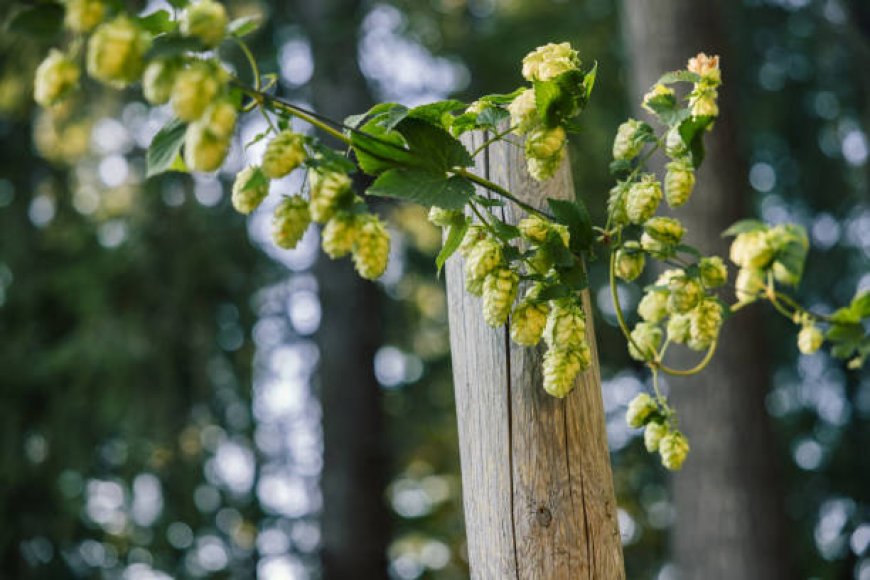Signs Your Hop Vines Are Getting Too Much Sun or Not Enough
Signs that your hop vines are getting too much sun include leaf discoloration, wilting, and stunted growth, while insufficient sunlight causes slow growth, weak stems, and reduced hop cone production. Balancing sunlight is essential for healthy hop vines, ensuring strong growth and a productive harvest.

Hop vines, a crucial element in beer brewing, require just the right amount of sunlight to thrive. As with many plants, too much or too little sun can significantly affect their growth, yield, and overall health. In the UK, where sunlight can be unpredictable, understanding the signs that your hop vines may be getting too much or not enough sun is essential to ensure a productive crop. In this blog, we will explore the key indicators of sunlight imbalance, how to rectify the issue, and how to keep your hop vines healthy throughout the growing season.
The Importance of Sunlight for Hop Vines
Hop vines (Humulus lupulus) are sun-loving plants that thrive in areas with long daylight hours. They require full sun exposure—at least 6-8 hours of direct sunlight per day—to grow properly. Sunlight plays a vital role in photosynthesis, enabling the vines to produce the sugars they need for growth and energy. Adequate sunlight also encourages the development of hop cones, the flowers used in brewing beer. Without enough sunlight, hop vines may become weak, underdeveloped, and more susceptible to disease.
However, there is such a thing as too much sun. In regions or during periods of extreme heat, hop vines can become stressed and suffer from sunburn or dehydration. Conversely, insufficient sunlight can cause stunted growth and a lack of hop cone production. Striking the right balance is key to ensuring your hop vines reach their full potential.
Signs Your Hop Vines Are Getting Too Much Sun
-
Leaf Discoloration and Burnt Edges One of the first signs that your hop vines are receiving too much sun is leaf discoloration. Leaves may start to turn yellow, brown, or appear scorched around the edges. This is typically a sign of sunburn, which occurs when the plant is exposed to excessive sunlight and cannot retain enough moisture to protect itself. The leaves, especially those at the top of the plant that receive the most direct sunlight, are the most susceptible.
-
Wilting and Drooping: Excessive sunlight can cause hop vines to wilt, even if they have been watered adequately. This happens because the plant loses moisture faster than it can absorb water from the soil. If your hop vines appear limp or droopy during the hottest part of the day but recover in the evening, it is a clear sign that they are experiencing heat stress due to too much sun.
-
Stunted Growth: Although hop vines generally thrive in the sun, too much exposure without adequate water can lead to stunted growth. This occurs because the plant is expending most of its energy trying to survive the extreme conditions rather than focusing on upward growth and hop cone production. If you notice your vines are not reaching their expected height or producing fewer cones, they may be struggling due to excess sunlight.
Signs Your Hop Vines Are Not Getting Enough Sun
-
Slow Growth and Weak Stems: Hop vines that do not receive enough sunlight will exhibit slow or stunted growth. These plants may also develop weak, thin stems that struggle to support the weight of the vine as it climbs. Hop vines need full sunlight to grow tall and strong, and insufficient light will prevent them from reaching their full potential. If your vines seem shorter than expected and have spindly stems, they likely need more sun.
-
Pale or Yellow Leaves: A lack of sunlight can also cause the leaves of your hop vines to turn pale or yellow. This is due to chlorosis, a condition where the plant cannot produce enough chlorophyll because it is not getting the sunlight it needs for photosynthesis. Yellowing leaves, especially those on the lower part of the plant, can indicate that your hop vines are not receiving enough sunlight to maintain healthy growth.
-
Reduced Hop Cone Production: One of the most critical indicators that your hop vines are not getting enough sun is a lack of hop cone production. Without sufficient sunlight, the plant will struggle to produce the energy needed to form cones. You may notice fewer or smaller cones, or in some cases, no cones at all. Since hop cones are the primary reason for growing hop vines, ensuring they receive enough sunlight is essential to a successful harvest.
How to Correct Sunlight Imbalance
Now that you know the signs of too much or too little sunlight, it’s important to take steps to correct the issue and ensure your hop vines get the optimal amount of sun.
-
For Too Much Sun
-
Provide Shade: If your hop vines are suffering from too much sun, consider providing some shade during the hottest parts of the day. You can do this by installing shade cloth or planting taller companion plants that can offer some protection from direct sunlight.
-
Increase Watering: Ensure that your hop vines are getting enough water to compensate for the extra sunlight. Hop vines are thirsty plants, especially during hot weather, and may need daily watering if temperatures are particularly high. Drip irrigation systems or soaker hoses can be beneficial for maintaining consistent moisture levels.
-
Mulch the Soil: Applying mulch around the base of the plant will help retain moisture in the soil and protect the roots from excessive heat. Mulch also helps prevent water evaporation, ensuring that your hop vines have a steady water supply even in extreme sun.
-
For Too Little Sun
-
Relocate the Vines: If your hop vines are not getting enough sunlight, the best solution may be to relocate them to a sunnier spot in your garden. Choose a location that receives at least 6-8 hours of direct sunlight per day. If moving the plants is not possible, consider pruning nearby trees or shrubs that may be blocking sunlight.
-
Thin Out the Vines: Overcrowded vines can block each other’s access to sunlight. Thinning out your hop vines by removing weaker stems will help improve airflow and ensure that each vine receives an adequate amount of sunlight.
-
Supplement with Artificial Light: In areas where sunlight is scarce, particularly during shorter days in autumn, you can supplement your hop vines with artificial grow lights. This is especially useful for hop growers in northern climates where natural sunlight may not be sufficient throughout the growing season.
Preparing for Future Growth: Hop Bines for Sale
As you nurture your current hop vines, you may be considering expanding your hop garden or replacing underperforming plants. If you're looking for high-quality hop bines for sale, there are many reputable suppliers in the UK offering a variety of hop strains suited to different climates and growing conditions. When choosing new bines, opt for varieties that are well-suited to your local sunlight and weather patterns. This will reduce the likelihood of sunlight imbalance and help you achieve a successful harvest.
Make sure to invest in healthy hop bines, as these will establish quickly and provide a better yield in the long run. Many online stores offer detailed guides on which varieties are best for different regions, so take advantage of their expertise when selecting your next batch of hop bines.
Conclusion
Growing healthy hop vines requires careful attention to sunlight levels. Too much or too little sun can lead to a host of problems, from sunburnt leaves to reduced cone production. By learning to recognise the signs of sunlight imbalance and taking steps to correct them, you can ensure your hop vines grow strong and produce an abundant harvest. Whether you're an experienced grower or just starting out, paying close attention to the sunlight your plants receive is essential to achieving success in your hop garden.
If you’re planning to expand or refresh your hop garden, don't forget to check out hop bines for sale from trusted suppliers, ensuring you choose the best varieties for your growing conditions. With proper care and the right balance of sunlight, your hop vines will thrive and provide bountiful yields for years to come.
What's Your Reaction?























![Ibis Paint X v12.2.13 MOD APK [Premium Unlocked] for Android](https://news.bangboxonline.com/uploads/images/202502/image_430x256_67a33ac8055c6.jpg)




